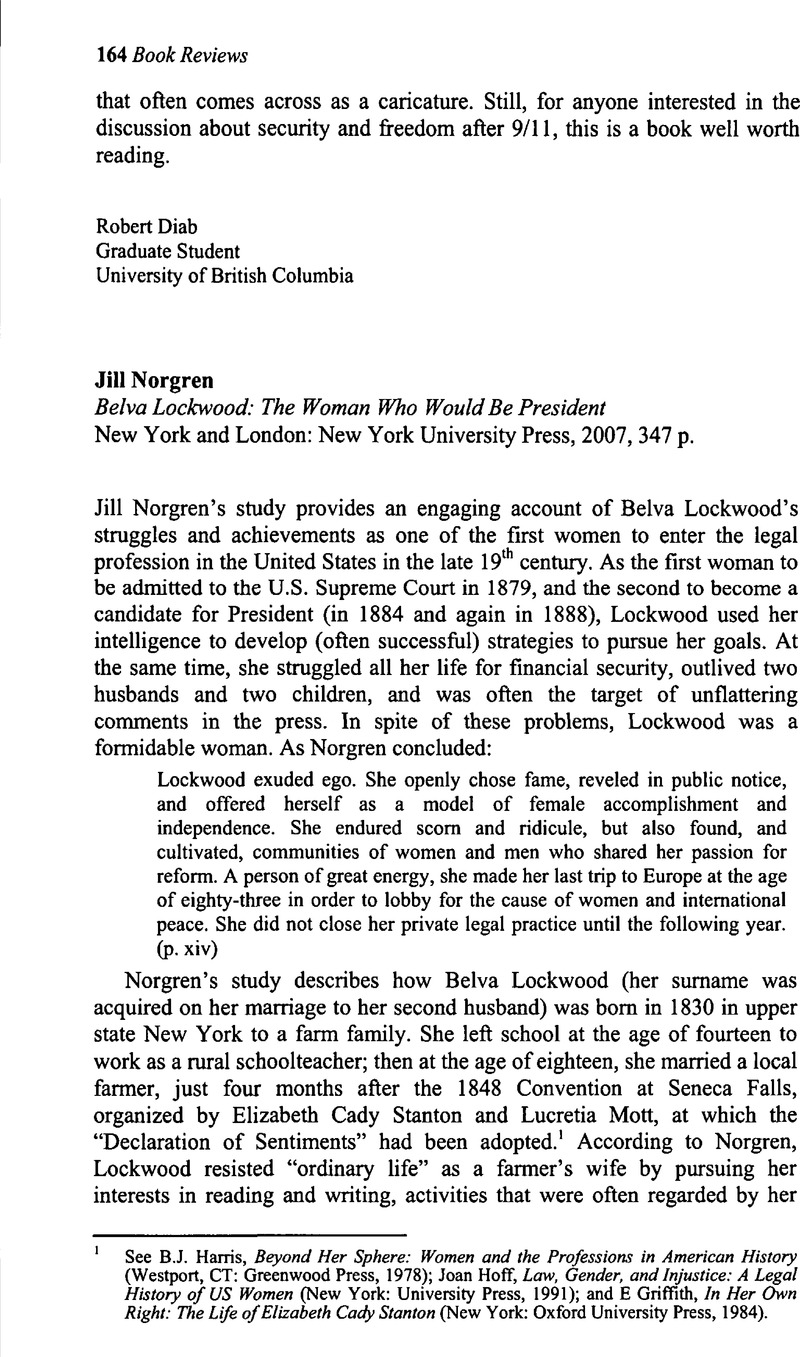No CrossRef data available.
Article contents
Jill Norgren Belva Lockwood: The Woman Who Would Be PresidentNew York and London: New York University Press, 2007, 347 p.
Published online by Cambridge University Press: 18 July 2014
Abstract

- Type
- Book Reviews/Comptes-Rendus
- Information
- Canadian Journal of Law and Society / La Revue Canadienne Droit et Société , Volume 22 , Issue 1 , April 2007 , pp. 164 - 168
- Copyright
- Copyright © Canadian Law and Society Association 2007
References
1 See Harris, B.J., Beyond Her Sphere: Women and the Professions in American History (Westport, CT: Greenwood Press, 1978)Google Scholar; Hoff, Joan, Law, Gender, and Injustice: A Legal History of US Women (New York: University Press, 1991)Google Scholar; and Griffith, E, In Her Own Right: The Life of Elizabeth Cady Stanton (New York: Oxford University Press, 1984)Google Scholar.
2 The first woman attorney in the District of Columbia was Charlotte Ray, who graduated from Howard University and was admitted to the bar in 1872; Ray was the daughter of a prominent African American minister. See Morello, K.B., The Invisible Bar: The Woman Lawyer in America 1638 to the Present (New York: Random House, 1986)Google Scholar; and Smith, J.C. Jr., Rebels in Law: Voices in the History of Black Women Lawyers (Ann Arbor: University of Michigan Press, 1998)CrossRefGoogle Scholar.
3 Stern, M., “The First Woman Admitted to Practice Before the United States Supreme Court: Belva Ann Lockwood” in Stern, , We the Women: Career Firsts of Nineteenth-Century America (Lincoln and London: University of Nebraska Press, 1962) 205 at 214Google Scholar.
4 Drachman, V.G., Women Lawyers and the Origins of Professional Identity in America: The Letters of the Equity Club, 1887-1890 (Ann Arbor: University of Michigan Press, 1993) at 58Google Scholar: letter from Belva A. Lockwood, 1887.
5 See In re Ricker, 66 New Hampshire Reports 207 (1890)Google Scholar; 29 A Rep 559.
6 Supra note 5.
7 Ibid.
8 See online: Women's Legal History Project <www.stanford.edu/group/WLHP>.
9 Mary Greene, an attorney admitted to the bar of Massachusetts, wrote to Frank to express disagreement with his unqualified admiration for Lockwood: “[It is] most unfortunate both for herself and for the cause of her sex that Belva Lockwood allowed herself to pose as a candidate for the Presidency upon the nomination of a set of women suffragists (not even a recognized political party).… I am simply telling you what the general sentiment in the United States is, in order that the value of your writing may not be impaired by giving prominence to those women who are more or less laughed at at home.… I do think that you ought to know what public opinion is here whether that opinion is just or unjust.…” Bibliothèque Royale, Brussels: Papiers Frank, #6031 (file 2): letter from Greene to Frank, 10 August 1891. See also Mossman, infra at 62.
10 See Weisberg, D.K., Women and the Law: A Social Historical Perspective, vol II (Cambridge, MA: Schenkman Publishing Company, Inc, 1982)Google Scholar; and “Belle A Mansfield” (1969) 55 Women Lawyers Journal 46Google Scholar.
11 Matsuda, M., “The West and the Legal Status of Women: Explanations of Frontier Feminism” (1985) 24 Journal of the West 47Google Scholar.
12 Drachman, V.G., Sisters in Law: Women Lawyers in Modern American History (Cambridge, MA: Harvard University Press, 1998)Google Scholar.
13 Gidney, R.D. & Millar, W.P.J., Professional Gentlemen: The Professions in Nineteenth-Century Ontario (Toronto: University of Toronto Press, 1994)Google Scholar.
14 See Mossman, infra at 5-16.
15 See Sanger, C., “Curriculum Vitae (Feminae): Biography and Early American Women Lawyers” (1994) 46 Stanford Law Review 1245CrossRefGoogle Scholar; Fisher, B., “The Models Among Us: Social Authority and Political Activism” (1981) 7 Feminist Studies 100CrossRefGoogle Scholar; Heilbrun, C. G., Women's Lives: The View from the Threshold (Toronto: University of Toronto Press, 1999)CrossRefGoogle Scholar; and Babcock, B. Allen, “Reconstructing the Person: The Case of Clara Shortridge Foltz” in Bell, S. Groag & Yalom, M., eds., Revealing Lives: Autobiography, Biography and Gender (Albany: State University of New York Press, 1990)Google Scholar.




